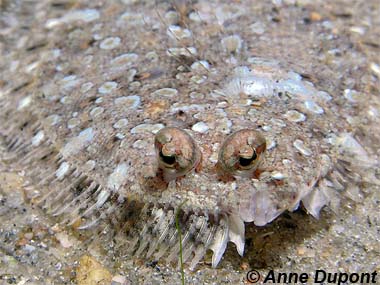
Bothus ocellatus
This flat fish spends most of its time laying in the sea bottom on its right side, adjusting its coloring to match its surrounding area. Although they all start out like normal fish, with one eye on either side of their heads, their right eyes migrate to the left side as they mature.
Order – Pleuronectiformes
Family – Bothidae
Genus – Bothus
Species – ocellatus
Common Names
The only English language common name is eyed flounder. Other common names include aramaçã (Portuguese), chueco playón (Spanish), ikan sebelah (Malay), lenguado de charco (Spanish), lenguado ocelado (Spanish), lenguado playón (Spanish), linguado (Portuguese), miracielo (Spanish), rombou ocellée (French), solha (Portugese), and tapaculo (Spanish).
Importance to Humans
Although flounder are considered an important group of food fishes for human consumption, the eyed flounder is of minor commercial importance due to its small size. They are often taken as bycatch in the shrimp trawl fisheries within its range, however they are considered a nuisance species because they become quite entangled in the nets and cannot be easily removed. Clearing the nets after heavy catches of small flatfishes requires manually removing the fish from the nets which can be quite time-consuming.
Conservation
The IUCN is a global union of states, governmental agencies, and non-governmental organizations in a partnership that assesses the conservation status of species.
> Check the status of the eyed flounder at the IUCN website.
Geographical Distribution
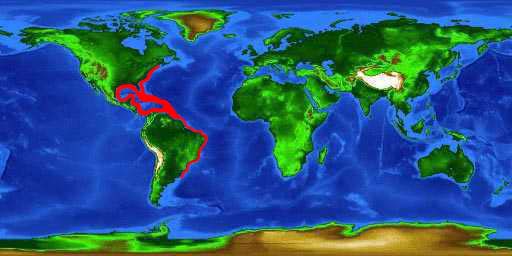
The eyed flounder is found from Canada south to New York, Bermuda and into the northern Gulf of Mexico south to southern Brazil.
Habitat
This member of the Bothidae family lives in sandy areas with coral rubble or seagrass beds nearby, typically near patch reefs. It is found from 3-360 feet (1-110 m) in depth but more commonly at depths to 165 feet (50 m). It lies motionless on the bottom substrate unless started. Attracted to lights, the larvae of this species are difficult to see because they are transparent.
Biology
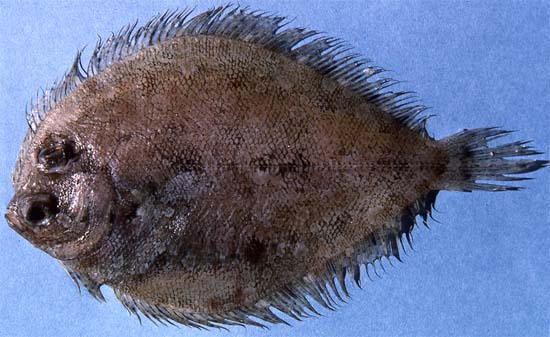
Distinctive Features
The disc-shaped body is laterally compressed resulting in a “flat fish”. The eyed flounder as a member of the family Bothidae, has protruding eyes located on the left side of the head. The eyes are relatively large in size. The protractile mouth is asymmetrical and downturned with the upper jaw extending posteriorly to or slightly beyond the anterior margin of the lower eye. Males have a spine at the tip of the snout and a bony protuberance above the lower eye. The upper eye has a fleshy ridge along the posterodorsal margin and the lower eye is anterior to the upper eye and has a fleshy ridge along the posterodorsal margin. The dorsal fin is long and originates above or anterior to the upper eye and is separate from the caudal fin; the pectoral and pelvic fins are present on the eyed flounder. The anal fin is separate from the caudal fin. The single lateral line is located behind the upper eye and is either faint or absent on blind side of the fish.
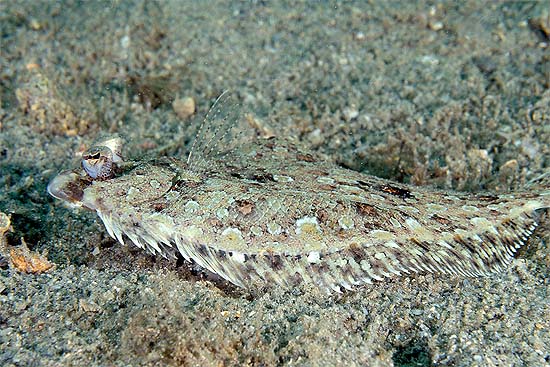
Coloration
The eyed flounder is dark brown to whitish with spots, blotches or ring-like markings on the ocular (eyed) side while the blind side is typically pale. Spots and mottling on the body is quite pronounced. The caudal fin lacks large spots on the distal portion of the median fin rays. If spots are present on the caudal fin, they are located one above the other. Experiments in the laboratory have revealed that the eyed flounder is capable of adaptive camouflage with coloration changing quickly (within 2-8 seconds) to closely mimic new backgrounds. This is an evolutionary adaption for avoid predation as well as to sneak up on prey.
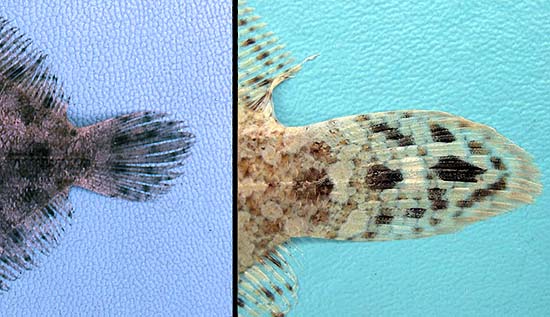
Bothus robinsi (twospot flounder) is a closely related species that may be confused with the eyed flounder. However, the twospot flounder has a caudal fin possessing two spots with one anterior to the other while the eyed flounder has spots that are located one above the other. The body coloration of the twospot flounder is generally darker with less pronounced spotting and mottling than the eyed flounder.
Dentition
The teeth in the jaws are small and sharp pointed, arranged in two rows. There are no teeth present in the vomer or palatine.
Size, Age, and Growth
The maximum reported size of the eyed flounder is 7.1 inches (18.0 cm) total length (TL), however it more commonly reaches a length of 4.7 inches (12.0 cm) TL.
Food Habits
Eyed flounders feed on small fishes along with crustaceans such as crabs, shrimps, amphipods and mantis shrimp as well as polychaetes.
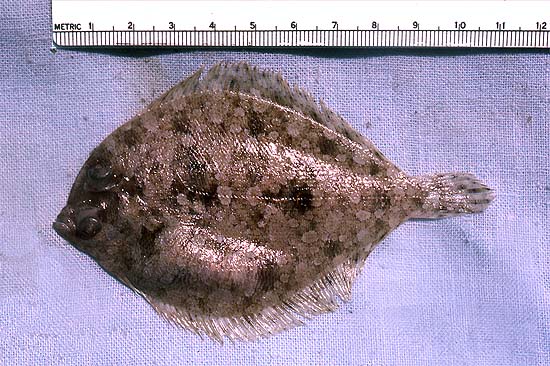
Reproduction
Although relatively little is known about the reproduction of most of the species within the order Pleuronectiformes, there has been some research on the reproductive activity of the eyed flounder during the winter months off the coast of Bonaire. Mating groups or harems consisted of one male and from 1-6 females with each female occupying distinct areas within the male’s territory. Courtship behavior is initiated approximately one hour before sunset with spawning beginning at sunset. The male positions himself under the female followed by the pair slowly rising to 15-75cm above the sandy substrate. There is a paired release of gametes from both the male and female. This spawning activity continued with the male attempting to mate daily with each female within its harem.
All flounders start life as pelagic fishes with bilateral symmetry with an eye on each side of the head. During larval development, flatfishes go through a metamorphosis during which one eye migrates from one side of the head to the other so that both eyes are eventually positioned on the same side of the head which is determined by the species. The eyed flounder has both eyes located on the left side of the adult fish.
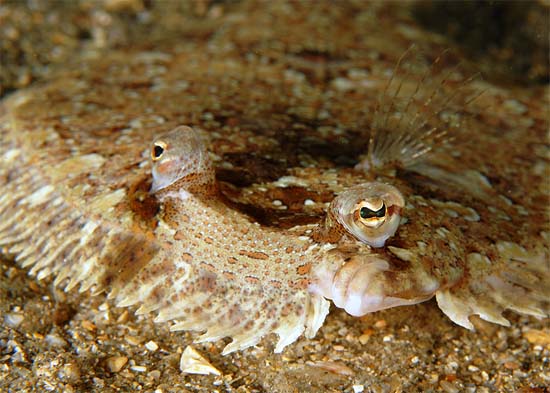
Predators
Flounders are preyed upon by numerous predators including invertebrates and vertebrates. The eggs and larvae are often consumed by jellyfish, ctenophores, worms, shrimps, and fish during their time in the plankton. Young flounders are fed upon by crabs, shrimps, and other fish while juvenile and adult flounder fall prey to many predatory fishes including cod, sculpin, striped bass, bluefish, cobia, groupers, moray eels, skates, stingrays, and sharks. Birds such as egrets, herons, and gulls, as well as marine mammals including seals and sea lions are also predators of flounder.
Taxonomy
The eyed flounder was originally described as Rhombus ocellatus in 1831 by Agassiz. This name was later changed to the currently valid Bothus ocellatus (Agassiz 1831). Synonyms referring to this species in past scientific literature include Platophyrs ocellatus Agassiz 1831 and Rhombus bahianus Castelnau 1855. The family Bothidae consists of the “lefteye flounders”, receiving this name because most species in this family lie on the sea bottom on their right side with both eyes located on the left side of the body.
Prepared by: Cathleen Bester